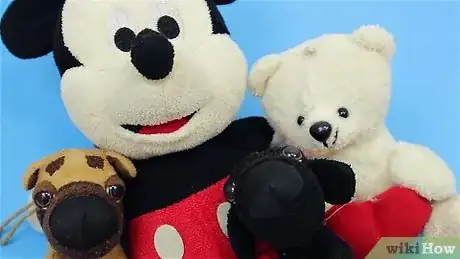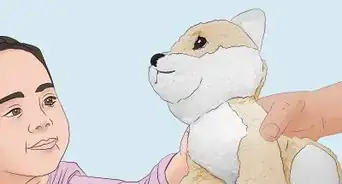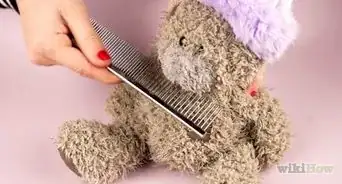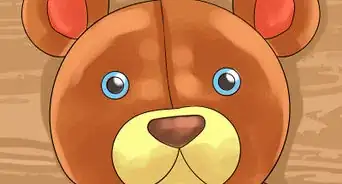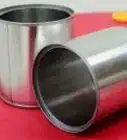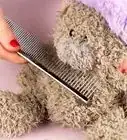wikiHow is a “wiki,” similar to Wikipedia, which means that many of our articles are co-written by multiple authors. To create this article, volunteer authors worked to edit and improve it over time.
There are 8 references cited in this article, which can be found at the bottom of the page.
The wikiHow Video Team also followed the article's instructions and verified that they work.
This article has been viewed 46,674 times.
Learn more...
While many stuffed toys are safe to wash with a regular load of laundry, you should still take steps to minimize the chance of damage. Toys with special significance or delicate parts should be washed by hand instead, using just enough water to clean the surface.
Steps
In a Washing Machine
-
1Check for signs of a delicate toy. Always read the tag if possible before putting a stuffed toy in the washing machine. If there are no washing instructions, look for these signs of delicate toys that should be washed using gentle methods only:[1]
- Non-removable electrical components (lights, voice box, etc.) or metal frames
- Movable limbs (they usually contain delicate wooden joints)
- Toys stuffed very densely, stuffed with foam or fiberfill, or that contain paper or plastic stiffeners (you can feel these when you squeeze the toy)
- Visibly aged or handmade toys
- Leather
- All rips and tears should be repaired before machine washing
- Toys over 18 inches (45 cm) in any dimension may be damaged in home laundry machines, but some laundromats have larger machines available
-
2Weigh the toy (optional). Stuffing can take a long time to dry once it's wet all the way through. If you weigh the toy before it gets wet, you'll know that it's mostly dry once it's back to its original weight.
- If you skip this step, there's a chance you won't give the toy enough time to dry. The internal moisture could cause rot or sagging.
Advertisement -
3Pre-treat stains (optional). You'll have the highest chance of removing dry stains if you rub on a mild laundry detergent and let it sit on the toy for ten minutes before you begin the laundry.
- A specialized stain removal cleaner may work, but test it on an inconspicuous area of the toy first to see if it causes discoloration.
-
4Put the toys in a zippered pillowcase. This will minimize damage from tumbling.[2] This is especially important in a top-load washer.
-
5Wash the toys in a cold, gentle cycle. Use a mild laundry detergent.[3] Avoid using fabric softener as it increases the flammability of fabrics.[4] Additionally, some fabric softeners cause respiratory irritation.[5]
- If none of your laundry detergents are labeled mild, look at the eco-friendly brands. In a pinch, you can use shampoo or dish detergent, but use ¼ or ⅓ of the recommended amount, as it will create a large amount of suds.
- If the stuffed toys are white, add chlorine bleach to the washing machine to sanitize them.[6] If they are colored, use color-safe bleach.[7]
-
6Air dry. Swing the toy sharply in the air a couple times to fling off surface moisture, then hang up to drip dry in a well-ventilated area. Once the toy has stopped dripping, move it to a well-ventilated area on a towel and leave it for several days to finish drying.
- Direct sunlight can cause color fading.
- You can sometimes feel damp lumps when you squeeze the toy. Once it feels normal again when squeezed, it is probably done drying.
Washing by Hand
-
1Check for delicate parts. Washing a toy in a sink or bathtub is safer than machine washing, but there are some toys that should not be submerged in water:
- Toys with electrical components that cannot be fully removed
- Toys filled with foam, fiberfill, or paper stiffeners
- Fragile toys with tears or wear from extremely heavy use
- Leather toys
-
2Submerge and squeeze the toy. Fill a tub, clean sink, or bathtub with cold water. Submerge the toy and squeeze, then lift it and squeeze out the water again. Repeat two or three times. This will remove light surface grime.
-
3Add mild detergent. Add a spoonful or two of mild laundry detergent or shampoo to the water and stir to make suds.[8]
-
4Scrub the toy, squeezing periodically. Use a clean toothbrush or stiff-bristled brush to scrub the dirt from the toy. Squeeze out the suds periodically.[9]
- This may work best if you squeeze the toy while partially submerged, so some air and suds get into it as well as water.
-
5Squeeze out and drip dry. Squeeze the toy to remove most of the water, but do not twist or wring it. Hang the toy up to drip dry, then put it on a towel to air dry for several days.
Extra-Gentle Cleaning
-
1Use other methods for young children. Young children, especially ones who put the toys in their mouth, should have their stuffed toys cleaned in hot water using one of the other methods, in order to sterilize them. If the toy cannot withstand the other washing methods, it may not be suitable for young children.[10]
-
2Remove dust and odor (optional). If you're cleaning toys without noticeable grime or stains, or extremely delicate toys, try one of these extra-gentle options. In most cases, you can skip down to the next step and start mixing soapy water instead.
- To remove dust, wet a cloth in plain water, then wring it out until it is almost completely dry. Gently wipe away the dust. Alternatively, use the hose attachment on a vacuum cleaner.
- To remove odor, put the toy in a paper bag with a spoonful or two of baking soda. Close and shake the bag to coat the toy, let it sit 30 minutes, then brush out the baking soda with a dry towel.
- To remove light dirt on extra-fragile toys, put it in the bag with cornmeal instead, or brush the fur with a plastic comb that has not touched human hair or hair-styling products.
-
3Mix a bowl of soapy water. Fill a medium bowl with water and add a small amount of mild soap, shampoo, or detergent. Mix to create suds.
- Baby shampoo and mild wool detergent are especially soft on fur.
- If using any other cleaner, including non-mild detergent, dab it on an inconspicuous area with a cotton swab first and let it dry, to test for color changes or damage.
-
4Dampen a clean cloth. Wet the cloth and wring it out until it is almost dry. If the cloth is wet enough to soak into the stuffing, it can cause rot or other damage.
- If you are worried about water damage, just pick up some suds from the surface. Suds alone may not be effective for significant grime.
-
5Wipe the fur. Concentrate on the dirty areas only, or on one area at a time if cleaning the whole toy. Wet and thoroughly wring the cloth occasionally to keep it damp, but not wet.
-
6Rinse by wiping with plain water. Wet the cloth with plain water and wipe the toy to remove traces of soap. As before, wring the cloth out first so it is mostly dry.
-
7Dry the toy with a towel. Wipe the toy down with a clean towel. Move between different parts of the towel as you go, as the towel becomes damp. Once the toy feels dry, give it one final rub against the nap of the fur to remove the last of the moisture.
-
8Let the toy air dry. Leave it in a well-ventilated area away from direct sunlight, until the last remaining moisture has evaporated. This should take less than an hour, unless the moisture penetrated the surface.
- Do not tumble dry or blow dry stuffed toys, as the heat can cause fading and damage.
Community Q&A
-
QuestionSo we can't use the dryer? (To dry them.)
 Community AnswerMany toys are too delicate or made from materials that can't withstand the heat of a tumble dryer. Eyes, noses, whiskers, etc. can be broken, chipped or melted. Manes can be melted, as can tails. To avoid damaging the toys, it is much safer to let the toy air dry.
Community AnswerMany toys are too delicate or made from materials that can't withstand the heat of a tumble dryer. Eyes, noses, whiskers, etc. can be broken, chipped or melted. Manes can be melted, as can tails. To avoid damaging the toys, it is much safer to let the toy air dry.
Warnings
- Be aware of color bleeding risk when adding the toys to a laundry load.⧼thumbs_response⧽
- Heat from blow drying or a tumble dryer can cause damage, especially to plastic parts.⧼thumbs_response⧽
References
- ↑ https://www.mamaslaundrytalk.com/how-to-wash-stuffed-animals/
- ↑ https://offspring.lifehacker.com/how-to-wash-your-kids-precious-stuffed-animals-1803133014
- ↑ https://offspring.lifehacker.com/how-to-wash-your-kids-precious-stuffed-animals-1803133014
- ↑ https://vtechworks.lib.vt.edu/handle/10919/32307
- ↑ https://pubmed.ncbi.nlm.nih.gov/10872633/
- ↑ https://www.canr.msu.edu/news/prevent_the_spread_of_germs_on_your_childrens_toys
- ↑ https://necsi.edu/coronavirus-guidelines-for-cleaning-and-disinfecting-to-prevent-covid-19-transmission
- ↑ https://housewifehowtos.com/do-laundry/how-to-wash-stuffed-animals/
- ↑ https://housewifehowtos.com/do-laundry/how-to-wash-stuffed-animals/
